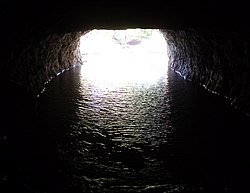Montgomery Bell Tunnel
|
Montgomery Bell Tunnel
|
|

Montgomery Bell Tunnel (interior view)
|
|
| Nearest city | White Bluff, Tennessee |
|---|---|
| Coordinates | 36°8′48.6″N 87°7′19.4″W / 36.146833°N 87.122056°WCoordinates: 36°8′48.6″N 87°7′19.4″W / 36.146833°N 87.122056°W |
| Built | 1819 |
| MPS | Iron Industry on the Western Highland Rim 1790s-1920s MPS |
| NRHP Reference # | 94001188 |
| Significant dates | |
| Added to NRHP | April 19, 1994 |
| Designated NHL | April 19, 1994 |
The Montgomery Bell Tunnel, also known as the Patterson Forge Tunnel, is a historic water diversion tunnel in Harpeth River State Park in Cheatham County, Tennessee. Built in 1819, most likely by slave labor, the 290-foot (88 m) long tunnel is believed to be the first full-size tunnel built in the United States, and is the first used to divert water for industrial purposes. It was designated a Historic Civil Engineering Landmark in 1981, and a National Historic Landmark in 1994.
The Montgomery Bell Tunnel is located in a unit of Harpeth River State Park, north of the town of Kingston Springs, Tennessee. In this area, the Harpeth River undergoes a series of meanders. In one of these, two parts of the river are quite close after a lengthy oxbow, known as the Narrows of the Harpeth. The tunnel runs roughly north-south across this isthmus. It is 290 feet (88 m) in length, and is dug entirely through limestone rock. Neither the tunnel nor its portals are lined in any way. The tunnel's profile shape that of a rectangle topped by a segmented arch, and is generally 8 feet (2.4 m) high and 15 feet (4.6 m) wide. The entrance portal is 12 feet (3.7 m) high and 35 feet (11 m) wide and the exit portal is 9.5 feet (2.9 m) high and 16 feet (4.9 m) wide. The tunnel has suffered some damage over the years due to erosive forces.
Montgomery Bell, an entrepreneur from Pennsylvania who was involved in iron foundries in central Tennessee, purchased the land in this area in 1818. Recognizing the potential to apply water power to the process of producing wrought iron, he directed the construction of this tunnel, which facilitates use of a 16-foot (4.9 m) drop in river height for power generation. It is presumed that the labor involved in digging the tunnel was slave labor: Bell owned 83 slaves, the most in the county at the time.
...
Wikipedia


